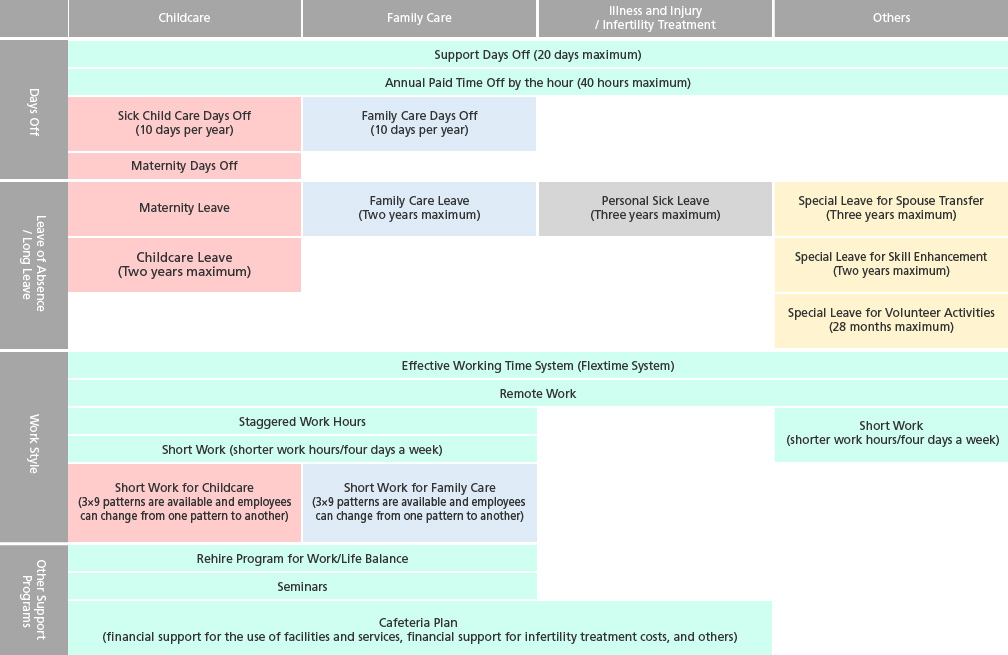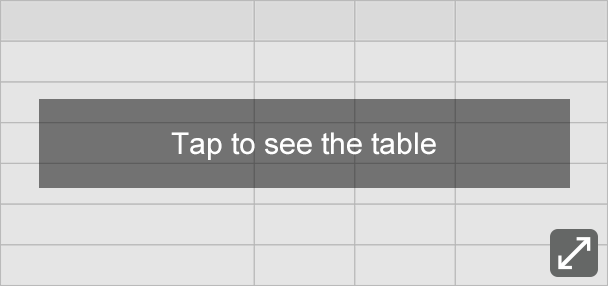- Home
- Sustainability
- Society
- Various Systems for Supporting a Healthy Work-Life Balance
Main content
Main content
Various Systems for Supporting a Healthy Work-Life Balance
Overview of various systems aimed at supporting employees juggling work and family life (promotion of a healthy work-life balance) (Ricoh in Japan)

| Common | Support Days Off (Paid days off used for childcare, family care, etc) |
A program Childcare/ family care leave and shorter working hours to use them in the future for designated purposes (20 days maximum). The paid days saved in the reserve may be used for sick child care, family care, maternal protection during pregnancy, support for a pregnant spouse, absence for personal illness, clinic visit for fertility treatment, volunteer activities, and child care during class closure due to the spread of infectious diseases. Employees will be paid upon using their Support Days Off for these designated purposes. |
|---|---|---|
| Annual Paid Time Off by the hour | For five days out of their annual paid days off, employees may take time off by the hour (up to 40 hours), for any reason. | |
| Effective Working Time System | A work style system that allows employees to determine their daily work start and end time between 7:00 am and 8:00 pm. Employees work the prescribed working hours per month. No core time. | |
| Remote work | A work style system that allows employees to work at home, in internal or external satellite offices, public spaces, and other places away from their assigned workplaces. No limit is set for the number of days of remote work. | |
| Staggered Work Hours | A work style system that allows employees to stagger their prescribed work start and end times for caring for a child under the sixth grade of elementary school, caring for a family member in need of personal care, or for protecting the mother’s health during pregnancy. | |
Short work |
A work style system that allows employees to work shorter hours to realize a diverse work style that suits their life events, including childcare, family care, and any other reason. Employees may choose to work shorter hours (six or seven hours) or work four days a week. | |
Rehire Program for Work/Life Balance |
This program provides future rehire opportunities for employees who are resigning for marriage, pregnancy, childbirth, childcare, family care, or spouse transfer, and who wish to be rehired in the future. | |
Cafeteria Plan |
Provides a selection of childcare and family care related facilities and services, financial assistance for purchase and rental costs, and assistance for fertility treatment costs within a specified monetary point for each employees. (Babysitters, lactation support services, day care services, home helpers, etc.) | |
| Childcare | Sick Child Care Days Off | Employees may take paid days off for caring for a sick child under the sixth grade of elementary school, up to ten days per year for two or fewer children, from the third child, an additional five paid days for each additional child. Sick Child Care Days Off may be taken by the hour. |
| Support Days Off (Paid) used for childcare | Up to 20 days/ year , Support Days off can be used for childcare (paid) | |
| Maternity Days Off | A program that allows pregnant employees to take breaks (unpaid) and time off for avoiding commuting rush hours or taking a rest. Female employees may also take rests and time off for visiting a maternity clinic during pregnancy and after childbirth as well as rests and time off after childbirth. In cases when a doctor diagnoses that the employee is unable to work, such as an imminent miscarriage or pregnancy toxemia, the employee status will be changed to personal illness and is entitled to receive supplemental pay from the fourth day after the day of absence. |
|
| Maternity Leave | Leave of absence for six weeks before delivery childbirth and eight weeks after delivery childbirth. Employee may take paid annual days off before or after the leave to extend the leave period. To partially fulfill the unpaid salary, employees can claim maternity allowance through the Ricoh Group Health Insurance Society. |
|
| Childcare Leave | Employees may take a leave of absence until their child becomes two years old. No wages will be paid by the company to employees during childcare leave. However, employees will receive childcare leave benefits through employment insurance. Employees may take a childcare leave not only from the expected date of birth or the birth date of their child. If an employee elects to take three months or shorter childcare leave, the first ten days are treated as paid leave. | |
| Short Work for Childcare | Employees may work shorter working hours until their child enters the third grade of elementary school. They may choose from three patterns of working hours, and flexible work hours are also available. | |
| Seminars | A seminar is held once a year to support return after leave of absence. | |
| Family Care | Family Care Days Off | Employees may take Family Care Days Off up to ten days a year regardless of the number of family members who need personal care in daily life. Sick Child Care Days Off may be taken by the hour. |
| Support Days Off (Paid) used for family care | Up to 20 days/ year , Support Days off can be used for family care (paid) | |
| Family Care Leave | Employees may take a leave of absence for caring for a family member in need of personal care for up to two years. | |
| Short Work for Family Care | Employees may work shorter hours for caring for a family member in need of personal care for up to two years. They may choose from three patterns of work hours, and flexible work hours are also available. | |
| Personal Sick Leave | Employees may take a leave of absence for up to three years for a personal illness or injury. Employees are eligible for benefits up to three years which are provided by the company, the Mutual Aid Society, and the Ricoh Group Health Insurance Society based on their years of service. | |
| Special Leave for Volunteer Activities | Employees may take a leave of absence for up to 28 months for volunteer activities. | |
| Special Leave for Spouse Transfer | Employees may take a leave of absence for up to three years for a spouse’s transfer to a remote location. | |
| Special Leave for Skill Enhancement | Employees may take a leave of absence for up to two years for returning to school (graduate school) or studying abroad to acquire business qualifications. | |
